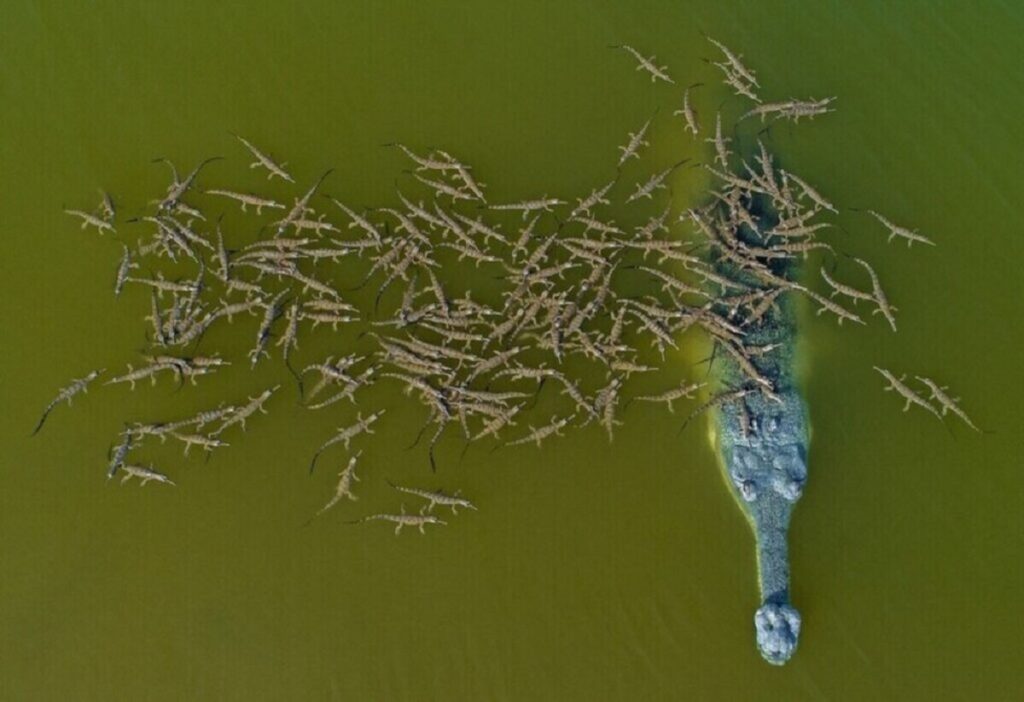In the heart of a wildlife sanctuary, a photograph was taken that almost seems like it belongs in a fantasy book. But trust me, this moment is as real as it gets: a massive crocodile, gently swimming in the sacred waters of the Ganges River, with not one, not ten, but a hundred baby crocodiles perched on his back. This remarkable image not only showcases the wonders of nature but also highlights the ongoing conservation challenges for an endangered species.
A Rare Sight in a Sacred River

The Ganges River, a revered and vital ecosystem, is home to many unique species, including the critically endangered gharial crocodile. Photographer Dhritiman Mukherjee spent several weeks at a wildlife sanctuary, patiently observing the river’s flow and the wildlife it sustains. His dedication paid off with an extraordinary shot—a male gharial, possibly the patriarch of several young, carrying his offspring in a way rarely seen in the animal kingdom.
Unlike other crocodilian species, gharials have long, narrow snouts and sharp teeth. These characteristics make the typical method of carrying their young in their mouths impossible. Instead, the adult gharials have adapted by allowing their offspring to ride on their backs, keeping them safe from the strong river currents. It’s a fascinating and protective parenting strategy that ensures the young ones’ survival in their challenging environment.
The Father’s Role in Gharial Society
While it might seem unusual to see a giant crocodile ferrying his young on his back, this behavior plays a crucial role in their survival. With fewer than 650 adult gharials left in the wild, each juvenile’s survival is a matter of life and death. Patrick Campbell, senior reptile curator at the Natural History Museum, points out that these majestic creatures, which can grow up to four meters long and weigh nearly 900 kilograms, face immense challenges due to habitat loss and human encroachment.
The Chambal River, which holds the largest population of gharials, is home to around 500 of these animals, each struggling to survive in an increasingly fragmented habitat. Each successful breeding season offers a glimmer of hope for conservationists working tirelessly to protect the species.
Capturing the Heart of the River

Mukherjee’s photograph is more than just a rare wildlife moment; it embodies the essence of life, survival, and familial bonds in the animal kingdom. The patience and respect he displayed while capturing this shot speak volumes about his dedication to his craft and his love for the natural world. He kept a safe distance, letting his camera bring us closer to these majestic creatures without disturbing their natural behavior.
This incredible image has not only been shortlisted for the prestigious Wildlife Photographer of the Year award but has also won a competition hosted by the Natural History Museum, standing out among hundreds of other entries. As someone who believes in the power of storytelling, the image struck a deep chord with me. It serves as a reminder of the delicate balance of nature and how animals like the gharial adapt to their surroundings in the most unexpected ways.
In places like Austin, where community and conservation efforts go hand-in-hand, such stories resonate even more deeply. They remind us of our collective responsibility to protect the planet and its incredible inhabitants.
A Testimony to the Resilience of Nature
Mukherjee’s photograph serves as a testament to the resilience of nature and the spirit of fatherhood in the wild. It invites us to pause, reflect, and appreciate the complex relationships that exist within our world, often overlooked in the hustle and bustle of everyday life. In moments like these, we find ourselves captivated and inspired by the profound connections that unite all living beings on Earth.






